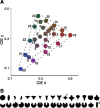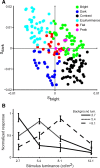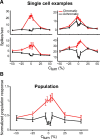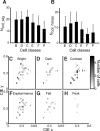Equiluminance cells in visual cortical area v4
- PMID: 21880901
- PMCID: PMC3171995
- DOI: 10.1523/JNEUROSCI.1890-11.2011
Equiluminance cells in visual cortical area v4
Abstract
We report a novel class of V4 neuron in the macaque monkey that responds selectively to equiluminant colored form. These "equiluminance" cells stand apart because they violate the well established trend throughout the visual system that responses are minimal at low luminance contrast and grow and saturate as contrast increases. Equiluminance cells, which compose ∼22% of V4, exhibit the opposite behavior: responses are greatest near zero contrast and decrease as contrast increases. While equiluminance cells respond preferentially to equiluminant colored stimuli, strong hue tuning is not their distinguishing feature-some equiluminance cells do exhibit strong unimodal hue tuning, but many show little or no tuning for hue. We find that equiluminance cells are color and shape selective to a degree comparable with other classes of V4 cells with more conventional contrast response functions. Those more conventional cells respond equally well to achromatic luminance and equiluminant color stimuli, analogous to color luminance cells described in V1. The existence of equiluminance cells, which have not been reported in V1 or V2, suggests that chromatically defined boundaries and shapes are given special status in V4 and raises the possibility that form at equiluminance and form at higher contrasts are processed in separate channels in V4.
Figures












Similar articles
-
Neuronal mechanisms of color categorization in areas V1, V2 and V4 of macaque monkey visual cortex.Behav Brain Res. 1996 Apr;76(1-2):51-70. doi: 10.1016/0166-4328(95)00183-2. Behav Brain Res. 1996. PMID: 8734043
-
Search for color 'center(s)' in macaque visual cortex.Cereb Cortex. 2004 Apr;14(4):353-63. doi: 10.1093/cercor/bhh001. Cereb Cortex. 2004. PMID: 15028640
-
Equiluminant red-green and blue-yellow VEPs in multiple sclerosis.J Clin Neurophysiol. 2001 Nov;18(6):583-91. doi: 10.1097/00004691-200111000-00010. J Clin Neurophysiol. 2001. PMID: 11779973
-
Visual Functions of Primate Area V4.Annu Rev Vis Sci. 2020 Sep 15;6:363-385. doi: 10.1146/annurev-vision-030320-041306. Epub 2020 Jun 24. Annu Rev Vis Sci. 2020. PMID: 32580663 Free PMC article. Review.
-
Neural mechanisms for color perception in the primary visual cortex.Curr Opin Neurobiol. 2002 Aug;12(4):426-32. doi: 10.1016/s0959-4388(02)00349-5. Curr Opin Neurobiol. 2002. PMID: 12139991 Review.
Cited by
-
Effects of luminance contrast on the color selectivity of neurons in the macaque area v4 and inferior temporal cortex.J Neurosci. 2014 Nov 5;34(45):14934-47. doi: 10.1523/JNEUROSCI.2289-14.2014. J Neurosci. 2014. PMID: 25378160 Free PMC article.
-
Accounting for Bias in the Estimation of r 2 between Two Sets of Noisy Neural Responses.J Neurosci. 2022 Dec 14;42(50):9343-9355. doi: 10.1523/JNEUROSCI.0198-22.2022. Epub 2022 Nov 17. J Neurosci. 2022. PMID: 36396403 Free PMC article.
-
Illusory light drives pupil responses in primates.J Vis. 2024 Jul 2;24(7):14. doi: 10.1167/jov.24.7.14. J Vis. 2024. PMID: 39046721 Free PMC article.
-
Measurements of neuronal color tuning: Procedures, pitfalls, and alternatives.Vision Res. 2018 Oct;151:53-60. doi: 10.1016/j.visres.2017.08.005. Epub 2017 Nov 20. Vision Res. 2018. PMID: 29133032 Free PMC article.
-
High-density recording reveals sparse clusters (but not columns) for shape and texture encoding in macaque V4.bioRxiv [Preprint]. 2023 Oct 17:2023.10.15.562424. doi: 10.1101/2023.10.15.562424. bioRxiv. 2023. Update in: J Neurosci. 2025 Jan 29;45(5):e1893232024. doi: 10.1523/JNEUROSCI.1893-23.2024. PMID: 37904996 Free PMC article. Updated. Preprint.
References
-
- Albrecht DG. Visual cortex neurons in monkey and cat: effect of contrast on the spatial and temporal phase transfer functions. Vis Neurosci. 1995;12:1191–1210. - PubMed
-
- Bichot NP, Rossi AF, Desimone R. Parallel and serial neural mechanisms for visual search in macaque area V4. Science. 2005;308:529–534. - PubMed
-
- Bradley A, Switkes E, De Valois K. Orientation and spatial frequency selectivity of adaptation to color and luminance gratings. Vision Res. 1988;28:841–856. - PubMed
Publication types
MeSH terms
Grants and funding
LinkOut - more resources
Full Text Sources
